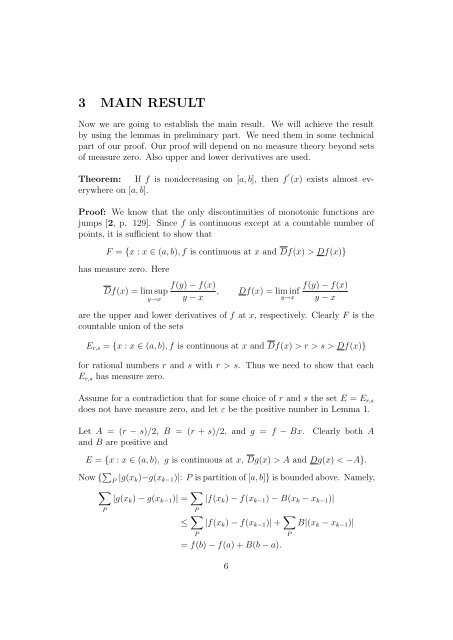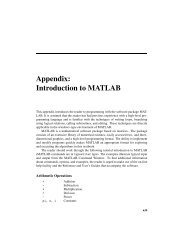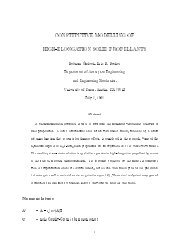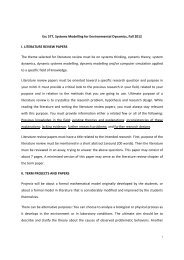an elementary proof of lebesgue's differentiation theorem
an elementary proof of lebesgue's differentiation theorem
an elementary proof of lebesgue's differentiation theorem
You also want an ePaper? Increase the reach of your titles
YUMPU automatically turns print PDFs into web optimized ePapers that Google loves.
3 MAIN RESULTNow we are going to establish the main result. We will achieve the resultby using the lemmas in preliminary part. We need them in some technicalpart <strong>of</strong> our <strong>pro<strong>of</strong></strong>. Our <strong>pro<strong>of</strong></strong> will depend on no measure theory beyond sets<strong>of</strong> measure zero. Also upper <strong>an</strong>d lower derivatives are used.Theorem: If f is nondecreasing on [a, b], then f ′ (x) exists almost everywhereon [a, b].Pro<strong>of</strong>: We know that the only discontinuities <strong>of</strong> monotonic functions arejumps [2, p. 129]. Since f is continuous except at a countable number <strong>of</strong>points, it is sufficient to show thatF = {x : x ∈ (a, b), f is continuous at x <strong>an</strong>d Df(x) > Df(x)}has measure zero. HereDf(x) = lim supy→xf(y) − f(x)f(y) − f(x), Df(x) = lim infy − xy→x y − xare the upper <strong>an</strong>d lower derivatives <strong>of</strong> f at x, respectively. Clearly F is thecountable union <strong>of</strong> the setsE r,s = {x : x ∈ (a, b), f is continuous at x <strong>an</strong>d Df(x) > r > s > Df(x)}for rational numbers r <strong>an</strong>d s with r > s. Thus we need to show that eachE r,s has measure zero.Assume for a contradiction that for some choice <strong>of</strong> r <strong>an</strong>d s the set E = E r,sdoes not have measure zero, <strong>an</strong>d let ε be the positive number in Lemma 1.Let A = (r − s)/2, B = (r + s)/2, <strong>an</strong>d g = f − Bx.<strong>an</strong>d B are positive <strong>an</strong>dClearly both AE = {x : x ∈ (a, b), g is continuous at x, Dg(x) > A <strong>an</strong>d Dg(x) < −A}.Now { ∑ P |g(x k)−g(x k−1 )|: P is partition <strong>of</strong> [a, b]} is bounded above. Namely,∑|g(x k ) − g(x k−1 )| = ∑ |f(x k ) − f(x k−1 ) − B(x k − x k−1 )|PP≤ ∑ |f(x k ) − f(x k−1 )| + ∑ B|(x k − x k−1 )|PP= f(b) − f(a) + B(b − a).6











